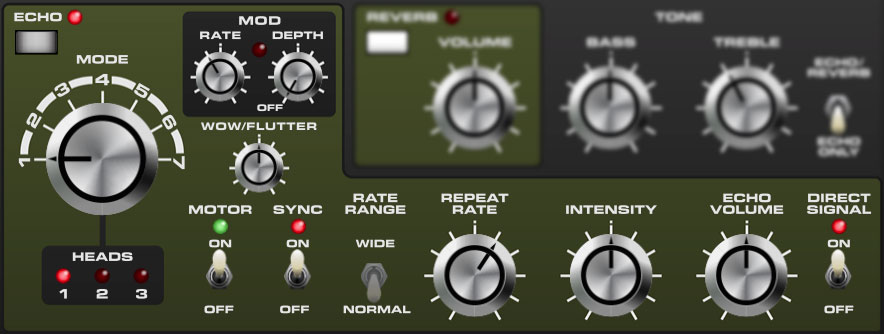
Stardust 201 reproduces the effect of a vintage "space echo" tape delay. Far from being super-pristine, vintage tape echoes have a lovely limited frequency response, and wow and flutter for a natural thickening effect.
On/Off (white button)- Enables and disables the echo effect.
Mode Selector and Heads 1/2/3 LEDs- Determines what combination of the three virtual "tape heads" are currently active; the LEDs illuminate to show the currently active heads. Head 1 is the shortest delay, head 3 is the longest. The time ratios of the heads are the same as a vintage RE-201 Space Echo as follow:
|
HEAD NUMBER |
TIME MULTIPLIER |
|---|---|
|
1 |
base time |
|
2 |
base time x 1.94 |
|
3 |
base time x 2.85 |
Mod Section
The Mod (modulation) section applies a sine wave LFO to the speed of the virtual "tape" for subtle-to-extreme time mod effects. This is sine wave only because if you think about the inertia of a tape mechanism speeding up and slowing down, sharp-edged waves (square, saw/ramp, sample & hold, etc.) don't make much sense - the end result would be that times would constantly be "chasing" the mod wave position. In the case of any congruent mod wave, you'd pretty much end up with a potentially inconsistent version of a sine wave anyway. Additionally, sine wave mod works best, because its constant curve means that pitch is always changing.
Rate and LED- Sets the Mod speed from 0.10 to 10 Hz. The LED blinks at the current Mod rate. The LED shuts off when the Depth knob is set to the Off position or the Echo section switch is disabled.
Depth- Sets the mod depth from 0 to 100%. At the risk of pointing out the obvious, if you don't want mod, make sure the Depth knob is set to zero, i.e. the Off position. Note that the LED stops flashing in the Off position.
––––––––––––––
Wow/Flutter- Besides being fun to say, wow and flutter refers to the speed variances inherent to mechanical tape transports. As you might surmise from the onomatopoeia-riffic terminology, "wow" refers to slow, undulating speed changes, whereas "flutter" refers to rapid, twitchy changes (In a related story, I once saw Onomatopoeia Zadora in a movie about a tennis instructor on Cinemax when I was 14). In hifi world, wow and flutter of any kind was considered detrimental, but in musical applications, these random changes result in subtle and desirable changes in the pitch of echoes. Stardust 201's Wow/Flutter knob lets you add the desired amount, from none to way-too-much.
Motor On/Off- This lets you shut off the virtual tape transport "motor." This makes a really cool noise, particularly with long echo times and high Intensity knob settings. Because the tape gradually slows down and speeds up as the switch is moved, it's easy to "play" - try assigning a MIDI/USB button.
Sync- Engaging the Sync switch locks the delays time to the current DAW project master tempo. When engaged, the Repeat Rate knob snaps to note values ranging from 1/64th note triplet to 8 beats. When Sync is enabled, the Rate Range switch is disabled.
Rate Range- Sets the echo time range. Normal corresponds to the time range of a vintage Space Echo unit (500 ms max at head 3), Wide extends the range by four times (2000 ms at head 3).
Repeat Rate- Sets the echo base time (see the Mode Selector table and Rate Range above for times). This control may seem "backwards," because on a real tape echo, it sets the motor speed, thus lower settings = slower motor speed = longer delay.
With that in mind, lower settings = slower motor speed, so the lower the knob setting, the longer the delay time. Note that the tooltip (the popup value display you see when turning a knob) always shows the delay time for head 1. To determine the exact delay times for heads 2 and 3, you can multiply the displayed time by the values shown in the table above (math is fun!).
Unlike typical analog or digital delays, when moved, the Repeat Rate knob models the inertia of a tape transport. This means delay times gradually speed up and slow down. Combined with high Intensity knob settings, this allows all manner of crazy Radiohead-esque echo feedback mayhem.
Intensity- Routes the output to the input for additional repeats, typically referred to as "feedback." At 0%, one repeat is heard, on up to infinitinely echoing feedback at high settings. Be careful, as this can potentially get loud, but generally speaking, it's pretty controllable and usually won't take your head off. We strongly recommend assigning MIDI hardware controllers to the Repeat Rate and Intensity knobs.
Echo Volume- Sets the volume of the echo signal. The dry level is not affected (this is how classic Space Echo units operate).
Direct Signal and LED- Setting this to Off removes the clean, unaffected signal from the echo signal chain. Use this when Stardust 201 is used as a bus send effect.